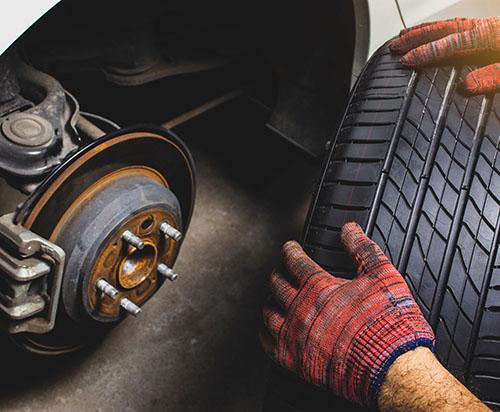Welcome to Tires4U2
Premium Automotive Service in Delray Beach, FL
Since 2005, Tires4U2 has been dedicated to providing the Delray Beach, FL area with exceptional service and unmatched automotive knowledge.
Tires4U2 takes pride in serving the community and building long-lasting relationships with our customers. Whether you need a routine oil change, brake inspection, or a major engine repair, we have the experience to get the job done right the first time. As a locally-owned shop, we use the latest technology and equipment to diagnose and repair your vehicle’s issues efficiently and effectively. We offer competitive pricing, transparent estimates, and a quick turnaround time, so you can get back on the road with confidence.
Having your vehicle in the shop can be a taxing experience, which is why we go above and beyond to make the process as smooth and stress-free as possible. We keep our customers informed throughout the repair process and are always available to answer any questions or concerns they may have. No matter what type of vehicle you drive, our team has the knowledge to provide you with the best possible service. Contact us today to schedule an appointment and experience the difference that our expertise and dedication to customer service can make for you and your vehicle.
Woman Operated Full Service Auto Repair Facility
Tires4U2
1 Linton Blvd #4
Delray Beach, FL 33444
(561) 272-2226
Mon-Fri: 8am-5:30pm
Saturday: 8am-1pm
Sunday: Closed



Tires4U2
1 Linton Blvd #4
Delray Beach, FL 33444
(561) 272-2226
Mon-Fri: 8am-5:30pm
Saturday: 8am-1pm
Sunday: Closed



Directions
Shop Amenities
Free WiFi
Courtesy Shuttle
Coffee & Snacks
Loaners
Shop Partners












Why Choose Tires4U2

When it comes to car repair, there are plenty of options available. But, not all auto repair shops are created equal. Our friendly and knowledgeable team has years of experience in the auto repair industry, from minor repairs to major overhauls- they’ve seen it all! That’s why we offer a variety of services to make your experience as hassle-free as possible.
At Tires4U2, our staff is always happy to answer any questions you may have and will keep you informed throughout the entire repair process. So why choose us for all your auto repair needs? The answer is simple: expertise, customer service, affordability, convenience, and quality. Contact us today to schedule your appointment and experience the difference for yourself.
- 24 Month/24,000 Mile Warranty
- Lifetime Warranty on Brake Pads & Shoes
- Trained Automotive Technicians
- Serving Delray Beach, FL Since 2005
The Absolute Best Car Service in Delray Beach, FL
What sets Tires4U2 apart from all of the others in Delray Beach, FL?
Trust: When it comes to auto repair in Delray Beach, FL, it’s all about earning loyalty and trust by doing our very best every day. We are determined to earn and keep your trust.
Talent: At Tires4U2, you can rest easy knowing that our highly-skilled, experienced auto service professionals are handling your car. Our technicians bring years of experience, skill, and education to the Delray Beach auto repair table.
Time: We take the time we need to provide you with top quality car service in Delray Beach, FL, and we take the time to talk to you about what that means. We listen to you so we understand your needs and goals for your auto repair.
Recently Serviced Vehicles
-
2020 Honda Accord
Mileage67,903Service Date8/30/2024Services Performed- TIRE ROTATION
- Lubricate and check chassis. Change oil and oil filter. Check air filter and breather filter. Check all fluid levels and tire pressures. Preform Multi Point safety inspection.
GABRIELLE C. gave our service a 5 star review on 9/23/2024 -
2012 Volvo XC70
Mileage178,789Service Date9/20/2024Services Performed- (2) TIRE MOUNTING & HIGH SPEED BALANCE SERVICE – TIRES PROVIDED BY CUSTOMER. NO WARRANTY CAN BE GRANTED
ANGELA A. gave our service a 5 star review on 9/20/2024 -
2018 Volkswagen Passat
Mileage84,031Service Date9/7/2024Services Performed- Lubricate and check chassis. Change oil and oil filter. Check air filter and breather filter. Check all fluid levels and tire pressures. Preform Multi Point safety inspection.
CRISTINA E. gave our service a 5 star review on 9/8/2024 -
2019 Lincoln MKZ
Mileage42,729Service Date9/5/2024Services Performed- BREAK WHEEL LOCK – START WITH FRONT LEFT
JOAN S. gave our service a 5 star review on 9/6/2024 -
2017 Honda Civic
Mileage92,979Service Date9/3/2024Services Performed- TIRE REPAIR/ PATCH * ( Tire and wheel removal and proper dismounting of the tire from the wheel, reestablish an airtight seal of the tire's innerliner by patching the damaged area from inside/ Repair Limited to the Tread Area Only* ) /
GILSON S. gave our service a 5 star review on 9/4/2024 -
2024 Toyota Grand Highlander
Mileage26,024Service Date8/21/2024Services Performed- TIRE REPAIR/ PATCH * ( Tire and wheel removal and proper dismounting of the tire from the wheel, reestablish an airtight seal of the tire's innerliner by patching the damaged area from inside/ Repair Limited to the Tread Area Only* ) / LF TIRE
- TIRE ROTATION
- WHEEL ALIGNMENT Road test vehicle. Check all suspension and steering parts for wear. Check tire pressure and condition. Check riding height. Check alignment of all four wheels. Adjust caster, camber, toe-in, and thrust angle as needed on all four wheels.
ALEXANDER C. gave our service a 5 star review on 8/22/2024 -
2023 Tesla Model S
Mileage9,472Service Date8/19/2024Services Performed- TIRE REPAIR/ PATCH * ( Tire and wheel removal and proper dismounting of the tire from the wheel, reestablish an airtight seal of the tire's innerliner by patching the damaged area from inside/ Repair Limited to the Tread Area Only* ) /
- TIRE REPAIR ** NO WARRANTY ** /
MARK S. gave our service a 5 star review on 8/19/2024 -
2022 Toyota Camry
Mileage16,384Service Date8/17/2024Services Performed- TIRE ROTATION
STEVE G. gave our service a 5 star review on 8/17/2024 -
2023 Volkswagen Tiguan
Mileage11,478Service Date8/2/2024Services Performed- TIRE LEAK – PASSENGER REAR TIRE
- TIRE REPAIR ** NO WARRANTY ** /
DEREK L. gave our service a 5 star review on 8/8/2024 -
2021 Hyundai Elantra
Mileage39,675Service Date8/2/2024Services Performed- WHEEL ALIGNMENT Road test vehicle. Check all suspension and steering parts for wear. Check tire pressure and condition. Check riding height. Check alignment of all four wheels. Adjust caster, camber, toe-in, and thrust angle as needed on all four wheels.
MIGUEL M. gave our service a 5 star review on 8/2/2024 -
2015 Dodge Grand Caravan
Mileage32,630Service Date7/23/2024Services Performed- TIRE REPAIR/ PATCH * ( Tire and wheel removal and proper dismounting of the tire from the wheel, reestablish an airtight seal of the tire's innerliner by patching the damaged area from inside/ Repair Limited to the Tread Area Only* ) /
- TIRE ROTATION
PATRICIA H. gave our service a 5 star review on 7/23/2024 -
2019 Hyundai Santa Fe
Mileage56,926Service Date7/16/2024Services Performed- Lubricate and check chassis. Change oil and oil filter. Check air filter and breather filter. Check all fluid levels and tire pressures. Preform basic safety inspection. Road test vehicle.
MICHELLE P. gave our service a 5 star review on 7/16/2024
















